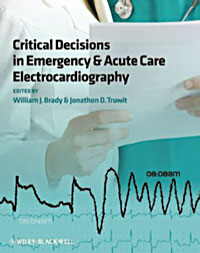Now electrocardiography is used in daily clinical practice, it is probably widely perceived to have lost its exciting mystique but the basic knowledge enabling accurate ECG interpretation is as important to emergency doctors as it is to electrophysiologists. Throughout this book there are many common clinical scenarios, which are well illustrated with good examples of ECGs. The topics covered appear thoroughly researched and supported by numerous references, useful for further reading. The contributors are a large number of senior medical professionals, the majority with a background in Emergency Medicine.

Editors: Brady WJ, Truwit JD
Publisher: Wiley-Blackwell,
Oxford, 2009
ISBN: 978-1-4051-5906-7
Price: £59.99
The book has a unique structure for a text about ECGs. It is divided into sections such as: the ECG in clinical practice; the ECG in acute coronary syndrome; and the ECG in critical care. Chapter titles within each section are questions such as: what are the limitations of the ECG in clinical practice?; how should the ECG be used in the patient during and following cardiac arrest?; and what QRS complex abnormalities result in ST segment elevation that may mimic or obscure AMI? Answers to these question comprise the chapter text, using case scenarios and ECG examples.
I found the chapter titled ‘What are the electrocardiographically silent areas of the heart?’ to be interesting and reflective of the general style of the book. Immediately following the case presentations, the answer to the question posed is briefly presented followed by a more in-depth discussion with ECG examples.
The title of this book might suggest it to be an easy-to-use, quick reference guide, perhaps suitable for daily use in the accident and emergency department or intensive care unit. The A4 size and information-packed 492 pages mean this is not the reality. The authors make no pretence to this initial assumption. It is, instead, to be used as an educational resource to develop on basic ECG interpretation skills.
Overall, I found this book to be unlike any other ECG book I have come across. It is informative and well illustrated but a little too protracted. Unfortunately, the ‘unique format’ makes it somewhat difficult to use in the Accident and Emergency Department.
